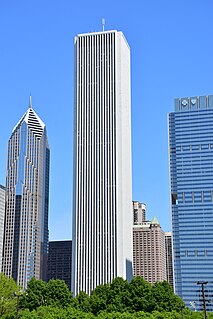
A skyscraper is a tall continuously habitable building having multiple floors. Modern sources currently define skyscrapers as being at least 100 metres (330 ft) or 150 metres (490 ft) in height, though there is no universally accepted definition. Skyscrapers are very tall high-rise buildings. Historically, the term first referred to buildings with between 10 and 20 stories when these types of buildings began to be constructed in the 1880s. Skyscrapers may host offices, hotels, residential spaces, and retail spaces.

The Aon Center is a modern supertall skyscraper in the Chicago Loop, Chicago, Illinois, United States, designed by architect firms Edward Durell Stone and The Perkins and Will partnership, and completed in 1974 as the Standard Oil Building. With 83 floors and a height of 1,136 feet (346 m), it is the fourth-tallest building in Chicago, surpassed in height by Willis Tower, Trump International Hotel and Tower, and St Regis Chicago.

Bank of New Zealand (BNZ) is one of New Zealand's big four banks and has been operating in the country since the first office was opened in Auckland in October 1861 followed shortly after by the first branch in Dunedin in December 1861. The bank operates a variety of financial services covering retail, business and institutional banking and employs over 5,000 people in New Zealand. In 1992 the bank was purchased by the National Australia Bank and has since then operated as a subsidiary, but it retains local governance with a New Zealand board of directors.
Bnz, BNZ, bnz or variant, may refer to:

Aon Center is a 62-story, 860 ft (260 m) Modernist office skyscraper at 707 Wilshire Boulevard in downtown Los Angeles, California. Site excavation started in late 1970, and the tower was completed in 1973. Designed by Charles Luckman, the rectangular bronze-clad building with white trim is remarkably slender for a skyscraper in a seismically active area. It is the third tallest building in Los Angeles, the fourth tallest in California, and the 58th tallest in the United States. The logo of the Aon Corporation, its anchor tenant, is displayed at the top in red.

The Majestic Centre, designed by Jack Manning of Manning Mitchell in association with Kendon McGrail of Jasmax Architects, was completed in 1991. The main building of the Majestic Centre is the Majestic Tower which is the tallest building in Wellington, New Zealand. The building, located on 100 Willis Street is 116 metres (381 ft) high and has 29 above ground storeys, making it the twelfth-tallest skyscraper building in New Zealand, along with the ASB Bank Centre in Auckland. It was, at the time of its completion, one of the three tallest buildings in the country, the two other contenders being built in the same year. It is to this day the furthest south 100M+ skyscraper in the world. It is mainly used as office space.

Rufino Pacific Tower or more commonly known as Rufino Tower or Rufino Plaza is an office skyscraper and is one of the tallest buildings in the Philippines and tallest buildings in Metro Manila. It remains as the tallest steel-framed building in the country. It has a ground to architectural top height of 161 metres (528 ft), one of three ways of determining building heights according to Council on Tall Buildings and Urban Habitat. Counting its eight-storey radio tower, the building has a total height of 200 metres (660 ft). It has a total of 41 stories above ground level, including a 10 storey podium which is actually the original building, the old V.A. Rufino Building, and was modified to be the podium of the new tower. It is one of the few skyscrapers that utilizes car elevators.
James Albert Beard was a New Zealand architect, town planner, and landscape architect.

Willis Street is a prominent street in the central business district of Wellington, the capital city of New Zealand. Along with Courtenay Place, Manners Street and Lambton Quay, the lower reaches of Willis Street form part of the "Golden Mile", Wellington's primary entertainment and retail district.

The Old Bank Arcade is a retail and office complex on a corner site at Lambton Quay, Wellington, New Zealand.

Plimmer Towers is a high-rise office and hotel complex in central Wellington, New Zealand, named after John Plimmer, active in business and politics during Wellington's early years. The building is 84m high and has 27 floors; when completed it was the tallest building in New Zealand until Auckland's 1981 Quay tower.

The Pacific Tower, located in the central city of Christchurch, New Zealand, has since its construction in 2010 been the city's tallest building at 86.5 metres (284 ft) in height, succeeding the Hotel Grand Chancellor and the PricewaterhouseCoopers building. It is also the tallest building in the world further south than Wellington. A major user of the building is the 171-room Rendezvous Hotel. The building was closed from the February 2011 Christchurch earthquake until 1 May 2013 for repairs. Levels 1 to 14 are used for the hotel, levels 15 to 22 are apartments and Level 23 is for services and plant room.

Sir George Alan Chapman is a New Zealand accountant, businessman and company director. He was president of the National Party from 1973 to 1982.












